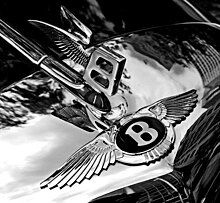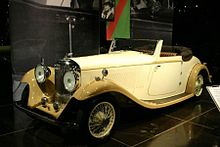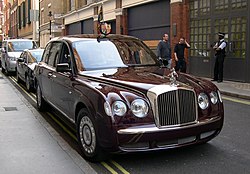Sunday, May 12, 2013
BENTLEY
Bentley Motors Limited is a British manufacturer of automobiles founded on 18 January 1919 by Walter Owen Bentley (known as W.O. Bentley or just "W"). Bentley had been previously known for his range of rotary aero-engines in World War I, the most famous being the Bentley BR1 as used in later versions of the Sopwith Camel. Since 1998, the company has been owned by the Volkswagen Group of Germany. The firm is based in Crewe, England with their Central Production Facilities being based there.
Contents[hide]
|
As a separate company (1919–1931)

It was on a visit to the DFP factory in 1913 that W.O. noticed an aluminium paperweight, and had the inspired idea of using the lightweight metal instead of cast iron to make engine pistons. The first Bentley aluminium pistons went into service in aero engines for the Sopwith Camel during the Great War.
The company was always underfunded, and Bentley turned to millionaire Woolf Barnato for help in 1925. As part of a refinancing deal, which resulted in his effectively owning the company, Barnato became chairman.
The Bentley Boys
A group of wealthy British motorists known as the "Bentley Boys" (Woolf Barnato, Sir Henry Birkin, steeplechaser George Duller, aviator Glen Kidston, automotive journalist S.C.H. "Sammy" Davis, and Dr. Dudley Benjafield among them) kept the marques reputation for high performance alive. Thanks to the dedication to serious racing of this group, the company, located at Cricklewood, north London, was noted for its four consecutive victories at the 24 hours of Le Mans from 1927 to 1930. Their greatest competitor at the time, Bugatti—whose lightweight, elegant, but fragile creations contrasted with the Bentleys rugged reliability and durability—referred to them as "the worlds fastest lorries".In March 1930, during the Blue Train Races, Woolf Barnato raised the stakes on Rover and its Rover Light Six, having raced and beat Le Train Bleu for the first time, to better that record with his 6½-litre Bentley Speed Six on a bet of £100. He drove against the train from Cannes to Calais, then by ferry to Dover, and finally London, travelling on public highways, and won; the H.J. Mulliner-bodied formal saloon he drove during the race as well as a streamlined fastback "Sportsman Coupé" by Gurney Nutting - he took delivery of on 21 May 1930 became known as the "Blue Train Bentleys"; the latter is regularly mistaken for (or erroneously referred to) as being the car that raced the Blue Train, while in fact Barnato named it in memory of his race.[2][3]
Car models

- 1921–29 3-litre
- 1926–30 4½-litre & "Blower Bentley"
- 1926–30 6½-litre
- 1928–30 6½-litre Speed Six
- 1930–31 8-litre
- 1931 4-litre
[edit] The Rolls-Royce era (1931–1998)





Rolls-Royce acquired Bentley secretly using an entity named the British Central Equitable Trust; not even Bentley himself knew the true identity of the purchaser until the deal was completed.[1] A new company, wholly owned by Rolls-Royce, was formed as Bentley Motors (1931) Ltd. Unhappy with his new subordinate role, W.O. Bentley left to join Lagonda in 1935 when his contract was up for renewal. The Cricklewood factory was closed and sold, and production moved to the Rolls-Royce works in Derby.
When the new Bentley 3.5 Litre appeared in 1933, it was a sporting variant of the Rolls-Royce 20/25, which disappointed some traditional customers yet was well-received by many others. Even Bentley himself was reported as saying, "Taking all things into consideration, I would rather own this Bentley than any other car produced under that name".[1]
After World War II, production of Rolls-Royce and Bentley cars was moved to an ex-wartime engine factory in Crewe, Cheshire. Bentleys increasingly became slightly lower priced Rolls-Royces sans the Rolls distinctive square-shouldered grille. By the 1970s and early 1980s sales had fallen badly; at one point less than 5% of combined production carried the Bentley badge.[1]
During this period Rolls-Royces parent company faltered, failing completely in 1970 following problems with aero engine development. The motorcar division was floated off and became Rolls-Royce Motors Ltd., which remained independent until bought by Vickers plc in August 1980.
Under Vickers, Bentley began to regain its high-performance heritage, typified by the 1980 Mulsanne. Bentleys restored sporting image created a renewed interest in the name and sales as a proportion of combined company output began to rise. By 1986 the Rolls-Royce:Bentley ratio had reached 60:40; by 1991 it achieved parity.[1]
For more on Bentley Motors from 1931 to 1998, see Rolls-Royce and Rolls-Royce Motors.
[edit] Car models
- 1933–37 3½-litre
- 1936–39 4¼-litre
- 1939–41 Mark V
- 1939 Mark V
- 1946–52 Mark VI
- 1952–55 R Type and Continental
- 1955–59 S1 and Continental
- 1959–62 S2 and Continental
- 1962–65 S3 and Continental
- 1965–80 T-series
- 1965–77 T1
- 1977–80 T2
- 1971–84 Corniche
- 1984–95 Continental — convertible
- 1992–95 Continental Turbo
- 1984–95 Continental — convertible
- 1975–86 Camargue
- 1980–87 Bentley Mulsanne
- 1984–88 Mulsanne L — limousine
- 1982–85 Mulsanne Turbo
- 1987–92 Mulsanne S
- 1984–92 Eight — basic model
- 1985–95 Turbo R — turbocharged performance version
- 1991–2002 Continental R — turbocharged 2-door model
- 1999–2003 Continental R Mulliner — performance model
- 1994–95 Continental S — intercooled
- 1992–98 Brooklands — improved Eight
- 1996–98 Brooklands R — performance Brooklands
- 1994–95 Turbo S — limited-edition sports model
- 1995–97 Turbo R — updated Turbo R
- 1995–2003 Azure — convertible Continental R
- 1996–2002 Continental T — short-wheelbase performance model
- 1997–98 Turbo RL — new Turbo R LWB (Long Wheel Base)
- 1997–98 Bentley Turbo RT — replacement for the Turbo RL
- 1997–98 RT Mulliner — Ultra exclusive performance model
- 1999–2002 Azure Mulliner — performance model
- 1999 Continental T Mulliner — firmer suspension
Volkswagen Group ownership (1998-present)
| | This section does not cite any references or sources. Please help improve this article by adding citations to reliable sources. Unsourced material may be challenged and removed. (September 2010) |

In 1998, Rolls-Royce and Bentley Motors were purchased from Vickers plc by Volkswagen Group for £430 million, following a bidding war with BMW. BMW had recently started supplying components for the new range of Rolls and Bentley cars, notably V8 engines for the Bentley Arnage, and V12 engines for the Rolls-Royce Silver Seraph. Volkswagen Group believed that the Rolls-Royce name was included in the purchase, when in fact it belonged to Rolls-Royce plc, the aero-engine company, and was used by the automobile division under licence. It also emerged that BMWs aeronautical division had a joint venture agreement with Rolls-Royce plc, and that the German company was able to terminate its supply deal with Rolls-Royce with 12 months notice, which would not be enough time for Volkswagen Group to re-engineer the cars.
BMW and Volkswagen Group entered into negotiations, and an agreement was reached whereby Volkswagen Group would manufacture both Bentley and Rolls-Royce cars until the end of 2002, licensing the name from Rolls-Royce plc; on 1 January 2003, the right to build Rolls-Royce cars would transfer to BMW. BMW licensed the brand from Rolls-Royce plc and paid £40 million to Volkswagen Group, but the deal did not include any manufacturing facilities, staff, or intellectual property on present or future models. BMW also agreed to continue its supply agreements, which gave Volkswagen Group the time it needed to reduce its reliance on BMW as a supplier. Bentley reintroduced the venerable Rolls-Royce V8 engine into the Arnage, initially as an additional model, and all BMW engine supply ended in 2003 with the end of Silver Seraph production.
Modern Bentleys


After acquiring the Company, Volkswagen spent £500 million to modernize the Crewe factory and increase production capacity.[4] As of early 2010, there are about 3,500 working at Crewe, compared with about 1,500 in 1998 before being taken over by Volkswagen.[5] It was reported that Volkswagen invested a total of nearly US$2 billion in Bentley and its revival.[6]
In 2002, Bentley presented Queen Elizabeth II with an official State Limousine to celebrate the Golden Jubilee. In 2003, Bentleys 2-door convertible, the Bentley Azure, ceased production, and the company introduced a second line, Bentley Continental GT, a large luxury coupé powered by a W12 engine built in Crewe.
Demand had been so great, that the factory at Crewe was unable to meet orders despite an installed capacity of approximately 9500 vehicles per year; there was a waiting list of over a year for new cars to be delivered. Consequently, part of the production of the new Flying Spur, a four-door version of the Continental GT, was assigned to the Transparent Factory (Germany), where the Volkswagen Phaeton luxury car is also assembled. This arrangement ceased at the end of 2006 after around 1000 cars, with all car production reverting to the Crewe plant.
In April 2005, Bentley confirmed plans to produce a four seat convertible model—the Azure, derived from the Arnage Drophead Coupé prototype—at Crewe beginning in 2006. By the autumn of 2005, the convertible version of the successful Continental GT, the Continental GTC, was also presented. These two models were successfully launched in late 2006.
A limited run of a Zagato modified GT was also announced in March 2008, dubbed "GTZ."
A new Bentley version of the Bentley Continental was introduced at the 2009 Geneva Auto Show: The Continental Supersports. This new Bentley is a supercar combining extreme power with environmentally friendly FlexFuel technology. A muscular two-seater with distinctive exterior and interior styling, the Supersports is unmistakably Bentley in design, craftsmanship and performance. The engine derived from Bentley’s current W12 power unit was re-engineered, re-tuned and re-mapped to achieve phenomenal supercar potency. 0-60 mph in 3.7 seconds (0–100 km/h 3.9 seconds). 621 brake horsepower (463 kW; 630 PS) 800 newton metres (590 ft·lbf) at 2,000 to 4,500 rpm. The Continental Supersports is the fastest, most powerful production Bentley ever.[7]
Bentley sales continued to increase, and in 2005 8,627 were sold worldwide, 3,654 in the United States. In 2007 the 10,000 cars-per-year threshold was broken for the first time in the companys history with sales of 10,014. For 2007, a record profit of €155 million was also announced.[8] Bentley reported a sale of about 7,600 units in 2008.[9] However, its global sales plunged 50 percent to 4,616 vehicles in 2009 (with the U.S. deliveries dropped 49% to 1,433 vehicles) and it suffered an operating loss of €194 million, compared with a profit of €10 million in 2008.[4][10]
- 1998 – Arnage saloon
- 1999 – Hunaudieres Concept
- 2002 – State Limousine
- 2003 – Continental GT coupé
- 2005 – Continental Flying Spur saloon
- 2006 – Azure convertible
- 2006 – Continental GT convertible
- 2007 – Continental GT Speed coupé
- 2008 – Bentley Brooklands coupé
- 2008 – Bentley Continental Flying Spur Speed saloon
- 2009 – Continental GTC Speed
- 2009 – Azure T
- 2009 – Arnage saloon, Final Series
- 2009 – Continental Supersports
- 2009 - Bentley Zagato GTZ[11]
- 2010 - Bentley Mulsanne
| Bentley automobiles, 1998–present | edit | |||||||||||||||||||||||
| Type | 1990s | 2000s | ||||||||||||||||||||||
| 8 | 9 | 0 | 1 | 2 | 3 | 4 | 5 | 6 | 7 | 8 | 9 | |||||||||||||
| Saloon | Arnage | Continental Flying Spur | ||||||||||||||||||||||
| Red Label | Arnage R/T | |||||||||||||||||||||||
| Arnage RL | ||||||||||||||||||||||||
| Coupé | Continental R | Continental GT | ||||||||||||||||||||||
| Continental T | Brooklands Coupé | |||||||||||||||||||||||
| Convertible | Continental GTC | |||||||||||||||||||||||
| Azure | Azure | |||||||||||||||||||||||
| Mulsanne-based | Arnage-based | Continental GT-based | ||||||||||||||||||||||
[edit] Management
The current board of management consists of Dr. Franz-Josef Paefgen, Chairman and Chief Executive; Dr. Ulrich Eichhorn, Engineering; Alasdair Stewart, Sales & Marketing; Douglas G. Dickson, Manufacturing; Christine A. Gaskell, Personnel; and Jan-Henrik Lafrentz, Finance. Dirk van Braeckel is current Head of Design.[edit] Recent Bentley racing
In 2001–03, the Bentley Speed 8 enjoyed a successful racing streak in the Le Mans series.[edit] Product Placement
Bentleys are known for making appearances in movies. According to MoviePlacement.com, Bentleys have been used by the main characters in films such as "The Thomas Crown Affair", "The Punisher", "Rushmore", "The Longest Yard", "The Hangover", "The Dark Knight", "GI Joe: The Rise of Cobra", "2012", and many others.
[edit] Future cars
Since Bentleys induction into Volkswagen Group, rumours of an SUV-style vehicle have repeatedly surfaced. These have been shot down by Bentley employees on the basis that the idea would not fit into their future plans and product portfolio.[12]
While diesel variants have been denied;[13] hybrid technology developed by Bentley owners, Volkswagen Group is another focal point as the trend towards hybrid cars is expanding year on year.
Other possible products in the pipeline include replacements for the Brooklands and Azure based on the all new Mulsanne platform[14] and a convertible variant of the Continental Supersports.[15] It has been reported that a second generation series of the Continental platform (GT, GTC and Flying Spur) are scheduled for release starting with the GT in 2010
Labels:
bentley